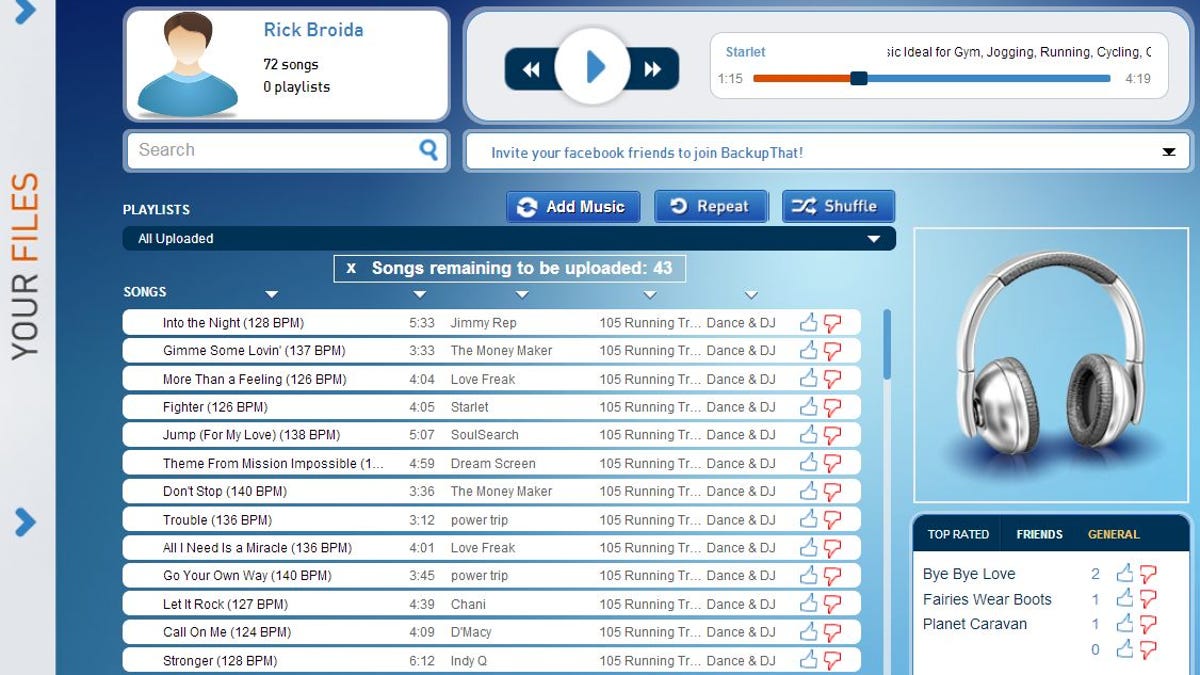Backup That turns your e-mail accounts into cloud storage
This intriguing, but extremely buggy, service lets you link multiple accounts for potentially unlimited storage for your files and music, all of it free of charge.
Savvy cloud-storage seekers know they can get 2GB free from Dropbox, 5GB from Google and SugarSync, 7GB from Microsoft, and so on.
Of course, there's no way to pool all that free storage into a single, unified cloud drive. That's precisely the idea behind Backup That, a new service that leverages the space available in your various e-mail accounts to give you potentially unlimited storage.
After registering for the beta, you choose one or more mail accounts to link to your Backup That account. The latter currently works with AOL, Gmail, GMX, Mobile Me, Yahoo, and other mail providers that support IMAP. (That leaves out Hotmail/Outlook, at least for now.) In theory, you can link as many accounts as you want, even going so far as to create new ones just to score more space (though Backup That won't do that for you).
From there you'll have access to Backup That's two main sections: Your Files and Your Music. The former is fairly self-explanatory: choose whatever files you want to upload to your account.
As for music, Backup That currently limits you to iTunes playlists. Choose one or more and a behind-the-scenes uploader starts copying them to your Backup That music library. (In the future, the service will add support for "MP3s outside of iTunes playlists.") From there you can stream your songs via any browser; an iPhone app is due in two to three weeks to allow on-the-go streaming.
The service is not currently optimized for use with Internet Explorer; the developers recommend using Chrome on a PC and Firefox on a Mac. In either case you'll need to install, or at least enable, Java. I tested it in Chrome, and came away impressed with the idea -- but not the execution.
That's because Backup That is extremely buggy. After linking up both AOL and Yahoo accounts, there was no indication of how much space might be available to me. The first time I attempted to upload a playlist, there was no indication that anything was happening -- other than a "songs remaining" counter that didn't seem to change. And when I refreshed the page, even that had disappeared. I tried again, then left it alone for a while. Songs did seem to upload in batches, but ultimately the upload timed out with about 43 songs remaining. When I tried one more time to upload the same playlist, it timed out after just 13 songs.
Another wrinkle is that there doesn't appear to be a way to manage or organize your songs. For example, I found no option for deleting individual songs or an entire playlist.
On the file side, it's easy enough to add individual files or folders, but I couldn't quite figure out the Sync option, which kept telling me to "select a file to download." And there's no file viewer at the moment; all you can really do is upload your files for holding and then download them again. You can right-click a file and choose "open," but that simply downloads and opens it locally (assuming the proper app is available).
Backup That has the potential to be a game-changer -- but it has a long way to go. The music component is more or less unusable as it is right now. And without some gauges indicating how much inbox space you've consumed in your account(s), there's the concern it might steal too much from your inbox and prevent you from receiving mail.
Here's hoping the service can iron out the bugs and become the cloud-storage solution we cheapskates have been waiting for.


